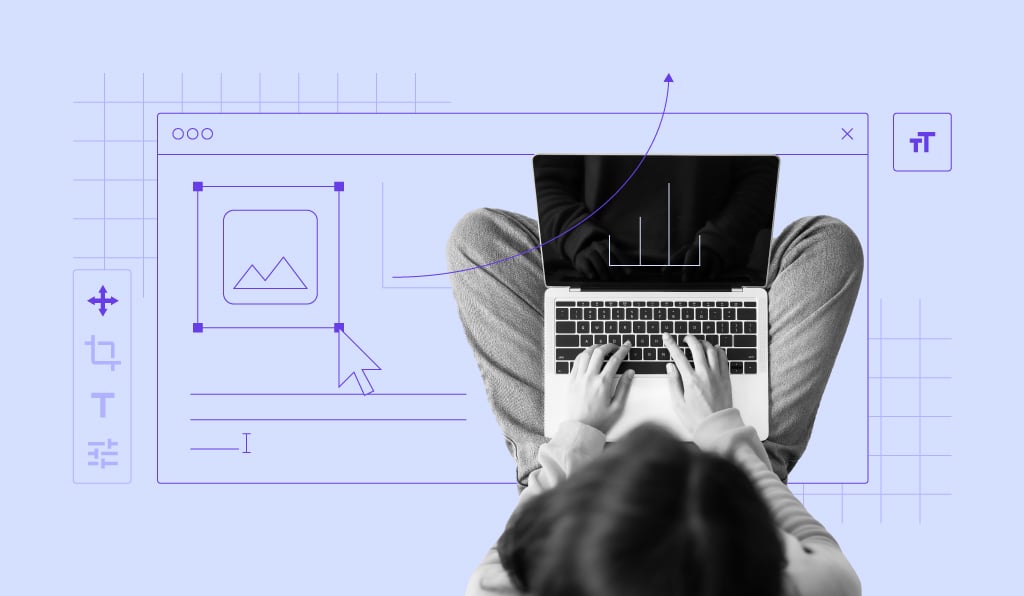Website Design London Ontario for High-Speed, Encrypted, and Scalable Sites
Website Design London Ontario for High-Speed, Encrypted, and Scalable Sites
Blog Article
How to Effectively Integrate Appearances and Functionality in Website Design
When making a site, you need to strike an equilibrium in between visual appeals and performance. It's not almost looking great; your design needs to also serve a function and overview customers effectively. By concentrating on simplicity and intuitive navigation, you can develop an interesting experience. Yet what components genuinely enhance use while maintaining visual appeal? Allow's explore the key concepts that can bring about a harmonious mix of elegance and feature.
Understanding the Value of Appearances and Performance
When you create an internet site, understanding the equilibrium between appearances and functionality is necessary for producing an effective customer experience. An aesthetically enticing site grabs focus, yet it's the functionality that maintains customers involved. Site visitors will swiftly shed interest and leave.Consider your target audience and what attracts them in if your site looks great however is challenging to navigate. You intend to develop a style that reflects your brand name while making sure simplicity of usage. Structured designs, intuitive navigating, and clear contact us to action can enhance both aesthetics and performance.

Concepts of Efficient Internet Design
To develop an efficient internet layout, you need to follow a number of essential concepts that enhance both customer experience and visual allure. First, focus on simplicity; a clean design assists users navigate quickly. Use a regular color design and typography to keep coherence across your website. This cultivates knowledge and trust.Next, assure your layout is receptive. Users gain access to websites on various tools, so your design should adjust perfectly. Take notice of visual pecking order; highlight essential components with positioning, shade, or dimension to assist customers' focus.Finally, integrate ample white area. It avoids mess and makes content much more digestible. Bear in mind, effective website design equilibriums aesthetics and capability, so every layout selection should serve a function. By adhering to these concepts, you'll create a website that's not just aesthetically appealing but also straightforward, eventually keeping site visitors involved and urging them to return.
Focusing On Individual Experience
When focusing on customer experience, you'll wish to start by recognizing what your customers absolutely need. Streamlining navigating design can make a significant difference in how quickly they find what they're looking for. Additionally, enhancing aesthetic hierarchy assists assist their attention to one of the most important elements on your website.
Comprehending User Needs
Understanding individual requirements is crucial for producing an engaging web experience that keeps site visitors returning. To attain this, you have to recognize the objectives and choices of your target audience. Start by conducting individual study, like studies or meetings, to collect insights on what individuals value most. When communicating with comparable internet sites, pay interest to their pain points and obstacles. This information permits you to customize your design, making sure capability straightens with user expectations. Furthermore, think about producing individual personalities that represent different sections of your target market, assisting you visualize their demands throughout the style procedure. When you prioritize comprehending user needs, you produce a web site that not only looks great but also delivers a seamless, enjoyable experience that cultivates loyalty.
Streamlining Navigation Layout

Enhancing Visual Pecking Order
A strong aesthetic power structure is crucial in directing users through your internet site and guaranteeing they involve with essential web content. To attain this, make use of spacing, dimension, and color strategically. Make essential aspects like headings larger and bolder than body message, drawing focus immediately. Use contrasting colors to highlight contact us to activity, encouraging clicks. In addition, use sufficient white space to different areas, making content absorbable and inviting.Consider the circulation of details; arrange elements rationally, leading individuals' eyes from one factor to the next. Use visual cues, like lines or arrowheads, to direct interest. By focusing on aesthetic hierarchy, you improve user experience and raise the chance of conversions, guaranteeing your website is both visually pleasing and functionally effective.
Shade Theory and Its Effect On Usability
While choosing the ideal shades for your site may appear like a minor detail, it significantly influences use and customer experience. Color impacts exactly how customers view information and can enhance or hinder navigation. For instance, contrasting colors can aid vital aspects stand apart, making it much easier for visitors to discover what they need.Additionally, consider the psychology of shades: blue often inspires count on, while red creates seriousness. Knowing your target audience can lead your color options, assuring they reverberate well.Moreover, regular color design help develop brand identification, making your web site more remarkable. Nevertheless, be mindful-- way too many shades can bewilder users. Adhere to a limited combination that enhances your web content and preserves clarity.Incorporating accessibility is likewise essential; confirm your color mixes get along for those with aesthetic impairments. By thoughtfully applying shade concept, you'll boost use and produce an extra engaging individual experience.
Typography: Balancing Design and Readability
Color options set the stage for your site, however typography plays an equally crucial function in boosting customer experience. You want your text to connect clearly while also reflecting your brand's character. Beginning by choosing font styles that are not just appealing however additionally understandable. Sans-serif font styles frequently work well for electronic screens, as they're easier to read at different sizes.Maintain a hierarchy by making use of various font dimensions and weights; this overviews users via your material effortlessly. Consider line spacing and letter spacing; as well tight can annoy visitors, while too loose can interrupt the circulation. Limit your font options to 2 or 3 to maintain the style cohesive.Finally, always check your typography across various gadgets and web browsers. What looks great on one display may out one more. Balancing style with readability guarantees that your message resonates, maintaining your audience informed and involved.
Responsive Design: Making Aesthetics Deal With All Devices
To assure your website looks excellent on any device, you'll require to accept receptive layout concepts. This method guarantees your site adapts to numerous display dimensions, supplying an ideal individual experience. Start by using fluid grids and versatile pictures that scale flawlessly. Rather than dealt with dimensions, select percents and relative units, enabling your layout to change dynamically.Next, execute media inquiries in your CSS. These let you apply various designs based upon device features, like screen width. In this manner, you can maintain aesthetic charm while guaranteeing functionality.Don' t forget touch targets; make certain buttons and web links are easy to touch on smaller sized displays. Focus on vital web content, so individuals can conveniently browse your site despite their gadget. By focusing on these elements, you'll produce an interesting, aesthetically appealing experience that satisfies the demands of all individuals, whether they're on a mobile phone, desktop computer, or tablet .
Carrying Out Usability Testing for Continuous Enhancement
To enhance your web design, you require to set clear functionality goals that line up with individual needs. By performing customer examinations, you can collect valuable responses on just how real people interact with your site. Assessing these results will assist you make educated improvements and develop an extra efficient individual experience.
Defining Usability Goals
While looks can draw users in, specifying usability objectives is necessary for guaranteeing their experience continues to be seamless and satisfying. Beginning by identifying what you desire customers to achieve on your website (website design london Ontario). Consider their jobs, habits, and needs. Are they searching for details, buying, or registering for a newsletter? Develop clear criteria to determine success, like job completion prices or time on task. Prioritize intuitive navigation, easily accessible web content, and responsive layout to boost usability. Regularly take another look at these objectives as user assumptions progress. By defining use objectives, you create a framework for assessing and boosting your site's performance. This focus on usability not just increases user complete satisfaction yet likewise reinforces the total effectiveness of your design
Conducting User Tests
Conducting user examinations is essential for fine-tuning your internet site and ensuring it satisfies your audience's needs. Start by determining your target individuals and producing a test plan that details your objectives. Use a mix of qualitative and quantitative methods, such as studies, meetings, and task-based monitorings, to gather complete responses. Welcome individuals to navigate your site while you observe their interactions and keep in mind any kind of difficulties they experience. Encourage open dialogue to catch their ideas and sensations regarding the style and capability. Keep sessions short and focused, ensuring you cover essential areas without frustrating customers. Make certain to record all findings, as this details will certainly be indispensable for making informed layout choices that improve both aesthetic appeals and use.
Analyzing Examination Results
Exactly how can you properly examine the results of your functionality tests to drive continual improvement? Start by classifying feedback into common themes. Search for patterns in user actions that highlight pain points or locations for improvement. Use measurable information, like job completion prices and time on job, to measure usability fairly. Don't fail to remember to take right into account qualitative insights from individual remarks; they often reveal underlying problems that numbers can not reveal. Prioritize one of the most impactful searchings for and produce workable items for your style group. Keep in mind, it's concerning iterating-- apply adjustments, after that examination again. This cycle of screening, examining, and refining assists you equilibrium looks and capability, ensuring your web site fulfills individual demands successfully while maintaining aesthetic appeal.
Frequently Asked Inquiries
Exactly how Do I Choose the Right Shade Scheme for My Website?
To pick the right color scheme for your site, consider your brand's character, target market, and emotional effect (website design london Ontario). Use color psychology, produce consistency, and warranty readability. Test combinations to see what resonates finest with site visitors
What Tools Can Help With Website Design Aesthetic Appeals and Capability?
You can utilize tools like Adobe XD, Figma, and Sketch to enhance your internet design's aesthetics and capability. These platforms use instinctive interfaces, click here collaboration attributes, and pre-made themes to enhance your creative process and enhance your layouts.
Just How Can I Incorporate Animations Without Compromising Functionality?
To integrate computer animations without jeopardizing performance, focus on subtle effects that enhance customer experience. Use CSS animations for smoother communications, assurance quick lots times, and test on different devices to preserve performance while adding aesthetic charm.
What Prevail Blunders to Prevent in Website Design Appearances?
When designing, stay clear of chaotic layouts, inadequate color options, and irregular font styles. Don't ignore mobile responsiveness, as it can alienate customers. Validate your design straightens with your brand name, developing a seamless experience that engages site visitors effectively.
Exactly how Commonly Should I Update My Internet site's Style for Optimal Aesthetics?
You need to update your website's design every 1-2 years to stay on par with fads and preserve excellent visual appeals. Routinely renewing visuals aids involve guarantees and visitors your website continues to be easy to use and enticing. When you develop a web site, recognizing the balance between looks and capability is vital for creating an efficient individual experience. To develop an effective web style, you require to adhere to numerous crucial concepts that enhance both individual experience and visual appeal. Users gain access to websites on numerous devices, so your style ought to adapt perfectly. When prioritizing user experience, you'll want to start by recognizing what your users genuinely require. Beginning by performing user research, like surveys or interviews, to collect understandings on what customers value most.
Report this page